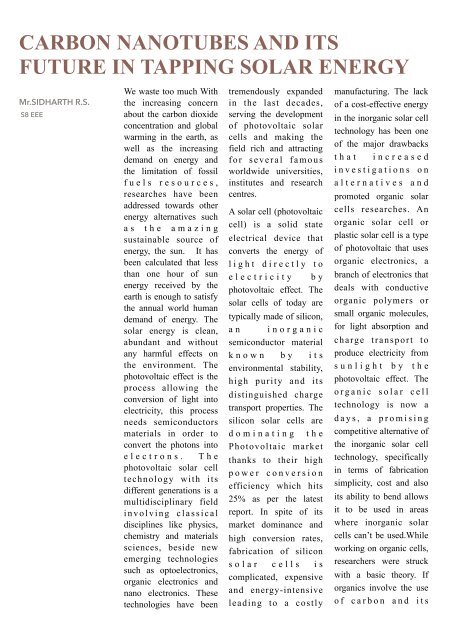combinepdf
Create successful ePaper yourself
Turn your PDF publications into a flip-book with our unique Google optimized e-Paper software.
film. In aligned CNT<br />
f i l m , t h e t r a n s p o r t<br />
distance is shortened, and<br />
the exciton quenching<br />
rate is also reduced.<br />
Additionally aligned<br />
nanotube film has much<br />
smaller void space, and<br />
b e t t e r c o n t a c t w i t h<br />
substrate. So, plus strong<br />
a c i d d o p i n g , u s i n g<br />
aligned single wall<br />
carbon nanotube film can<br />
further improve power<br />
conversion efficiency (a<br />
r e c o r d - h i g h p o w e r-<br />
conversion-efficiency of<br />
>11\% was achieved by<br />
Yeonwoong Jung).<br />
***<br />
ARTIFICIAL LEAF: SOLAR CELL<br />
THAT PRODUCES HYDROCARBON<br />
M r. H . R AV I S A N KA R<br />
MENON<br />
S8 EEE<br />
Researchers have<br />
developed a new type of<br />
solar cell that is capable<br />
of transforming carbon<br />
dioxide into usable<br />
hydrocarbon fuel using<br />
only sunlight as energy.<br />
C o m p a r e d w i t h<br />
conventional solar cells<br />
that convert sunlight into<br />
electricity to be stored in<br />
batteries, the new solar<br />
c e l l s c h e a p l y a n d<br />
efficiently convert carbon<br />
d i o x i d e i n t h e<br />
atmosphere directly into<br />
usable fuel.<br />
The new device works<br />
much like trees and<br />
plants that capture and<br />
convert carbon dioxide<br />
into sugars to store them<br />
into energy. Unlike plants<br />
that use catalysts to<br />
p r o d u c e s u g a r, t h e<br />
r e s e a r c h e r s u s e d<br />
n a n o f l a k e t u n g s t e n<br />
diselenide catalyst to<br />
convert carbon dioxide to<br />
carbon monoxide.<br />
o f o t h e r k i n d s o f<br />
hydrocarbons such as oil,<br />
gasoline and coal.<br />
A solar farm of these soc<br />
a l l e d a r t i f i c i a l<br />
leaves can also remove<br />
significant amounts of<br />
the greenhouse gas<br />
carbon dioxide in the<br />
atmosphere known to<br />
significantly drive global<br />
warming.<br />
In plants, the process of<br />
c o n v e r t i n g c a r b o n<br />
d i o x i d e i n t o s u g a r<br />
involves the organic<br />
catalyst enzyme. Carbon<br />
monoxide is also a<br />
p l a n e t - w a r m i n g<br />
greenhouse gas but<br />
scientists have already<br />
found a way to convert it<br />
into usable fuel such as<br />
methanol. Converting<br />
carbon dioxide into<br />
something usable, on the<br />
other hand, is more<br />
challenging because of it<br />
b e i n g r e l a t i v e l y<br />
chemically unreactive.<br />
packets of light, into<br />
p a i r s o f n e g a t i v e l y<br />
charged electrons and<br />
positively charged holes<br />
that separate from each<br />
other. When the holes<br />
r e a c t w i t h w a t e r<br />
molecules, protons and<br />
oxygen molecules are<br />
created. Along with<br />
carbon dioxide, the<br />
protons and electrons<br />
then react together to<br />
p r o d u c e c a r b o n<br />
monoxide and water.<br />
***<br />
The new solar cells<br />
produce usable energydense<br />
fuel, which could<br />
help address challenges<br />
linked with the burning<br />
The system involves a<br />
reaction very much<br />
similar to that found in<br />
nature. The artificial leaf<br />
converts photons, or




